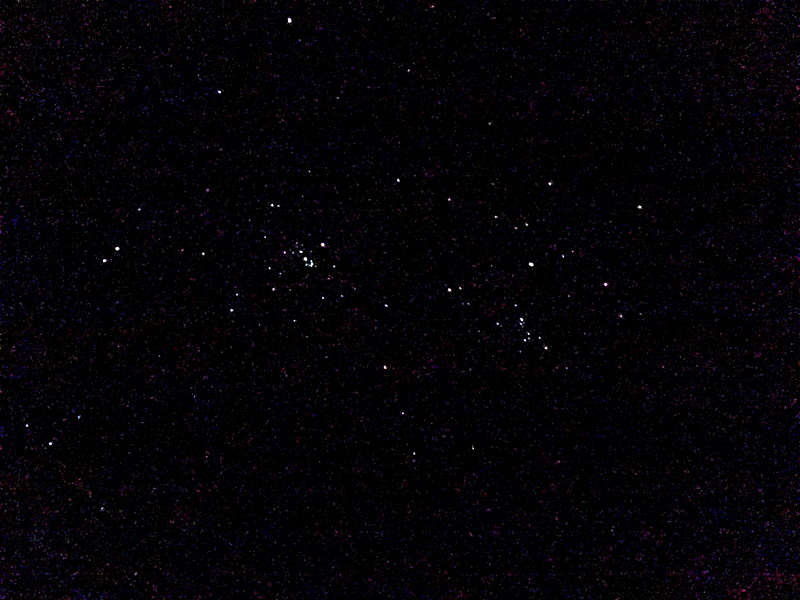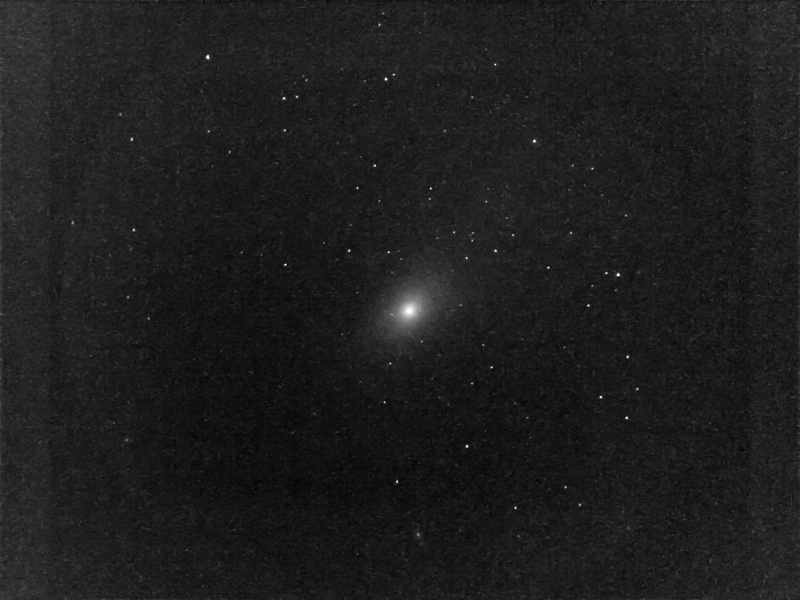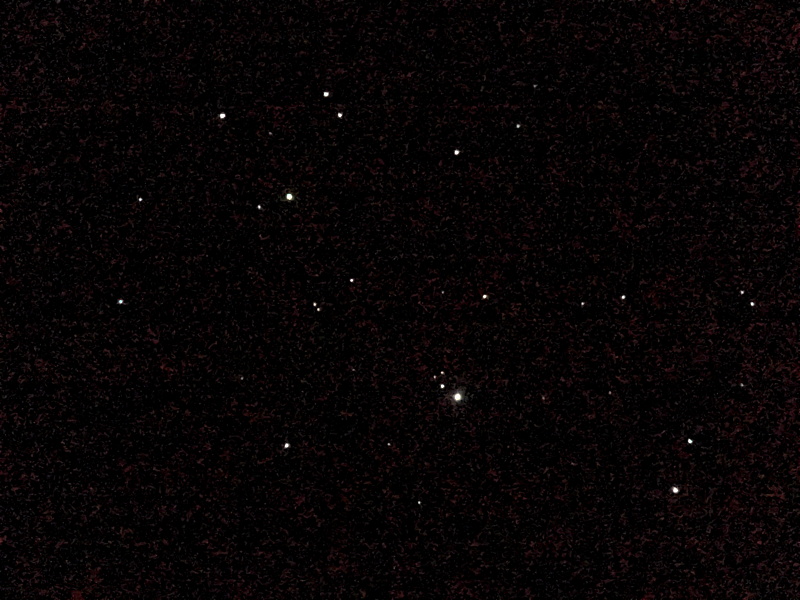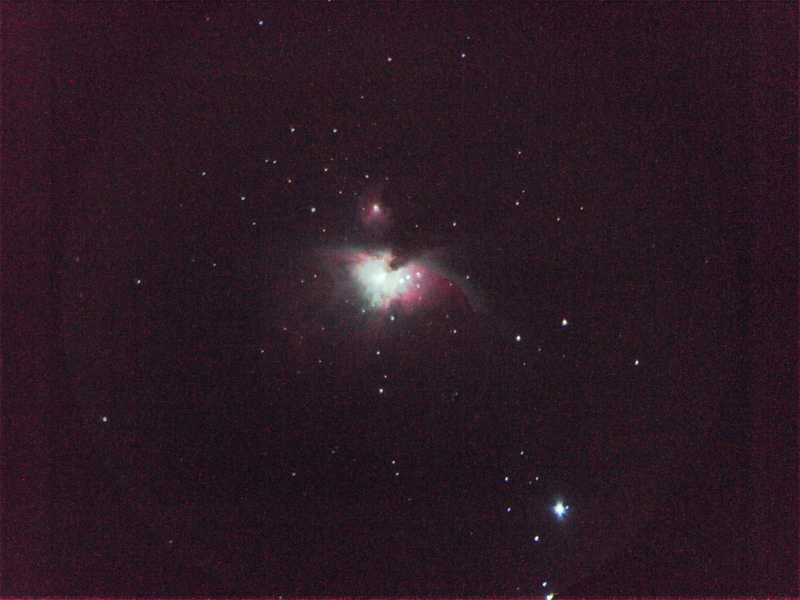DSO Observing, iPhone 6s Plus DSO Imaging with NightCap Pro
Posted: 10 November 2015
|
Open: Monday, 9 November 2015, 1814 MST Temperature: 66°F |
Session: 878 Conditions: Clear |
Added the Antares f/6.3 focal reducer to the 8" LX200-ACF telescope and used the Meade Series 5000 2" 24mm UWA eyepiece (53X) for most of the night's Deep Sky Object (DSO) viewing. First viewed Alpha Capricornus (double star) and then M30 (globular cluster). Next viewed NGC7209 and NGC7243 (open clusters) in Lacerta. Then viewed M31 (Andromeda Galaxy) and its companion galaxies M32 and M110. 1833 MST: saw a satellite pass through the field-of-view (FOV) close to M110. I then viewed NGC752 (open cluster) and NGC891 (galaxy) in the constellation of Andromeda. 1837 MST: saw another satellite pass near NGC891 in the FOV. Next viewed was the Double Cluster (NGC869 and NGC884, open star clusters).
Just to prove it could be done, here is an iPhone 6s Plus photo with the iPhone handheld over the eyepiece using the iOS app NightCap Pro (Light Boost, ISO 8000, 1/3sec):

Next viewed was M27 (Dumbbell Nebula, planetary nebula). I then wanted to see if M27 could be imaged with the iPhone handheld using NightCap Pro (Light Boost, ISO 8000, 1/3sec). This is the result:

The faint smudge in the center of this noisy image is M27. So it was captured, but not as well as I have done previously (see the iPhone Astrophotography photo album).
1858 MST: viewed M33 (Triangulum Galaxy). Switched to the Meade Series 4000 1.25" 26mm eyepiece (48X with the focal reducer) and mounted the iPhone on the telescope using the Orion SteadyPix Universal Smartphone Telescope Photo Mount. Took this image of M33 with NightCap Pro (Long Exposure, Light Boost, ISO 8000, 1/3sec, 1 minute):

The faint object at the center is M33. Amazing that a smartphone camera can capture M33. (or at least, part of it).
This next iPhone image is M31 (Andromeda Galaxy), with M32 just visible at the bottom of the image, taken with NightCap Pro (Long Exposure, Light Boost, ISO 8000, 1/3sec, 1 minute):

I removed the SteadPix and 26mm eyepiece, and switched back to the 24mm eyepiece (53X). Viewed M45 (the Pleiades, open cluster), low in the eastern sky. Took this handheld iPhone 6s Plus image with NightCap Pro (Light Boost, ISO 2500, 1/3sec):

1935 MST: viewed NGC246 (Skull Nebula, planetary nebula), NGC247 (galaxy), IC1613 (galaxy), and M77 (galaxy) in Cetus. Also viewed the variable star Mira.
2004 MST: viewed some DSOs in the constellation of Aquarius: M72 (globular cluster), M73 (open cluster), NGC7009 (Saturn Nebula, planetary nebula), M2 (globular cluster), and NGC7293 (Helix Nebula, planetary nebula). Next viewed M74 (galaxy) in Pisces. That was followed by a tour of bright stars in the constellation of Taurus.
I took a short break from observing to do some troubleshooting of the illuminator on the Antares 7x50 Illuminated Crosshairs Finderscope. The light had not been coming on reliably. After rotating the knob several times, off then on and back off, the illuminator began working reliably again. I also tweaked the finderscope alignment.
2055 MST: began trying to view M33 (Triangulum Galaxy) with the naked eye. It was near the zenith so was well placed for observing. I used the Celestron 12x70 Cometron Binoculars to first locate it. M33 was easily seen in the binoculars. Although it was a challenge with my old eyes, I was able to barely detect a smudge in the sky that was M33 using the naked eyes.
2108 MST: returned to the telescope and viewed M1 (Crab Nebula), low in the eastern sky. 2111-2132 MST: took a break to replenish my hot chocolate.
2140 MST: M42 was now higher in the sky and some nebulosity was seen at 53X. Swapped out the 24mm UWA eyepiece for an OPT 2" 50mm WA eyepiece (25X). Very pretty view at this low magnification and wide FOV.
2154 MST: saw the first Taurid meteor of the night. Very bright, fast moving in the south towards the west, with a nice trail. 2157 MST: saw another Taurid meteor; fast but fainter, in southeast moving south. 2159 MST: saw a bright non-Taurid meteor moving eastward near Auriga. 2204 MST: another nice bright Taurid meteor moving northward near Auriga. A piece broke off this one near the end.
2210 MST: took sky quality measurements using a Unihedron SQM-L meter and the iOS app Dark Sky Meter. Sky was 21.02 (SQM-L) this night.
2240 MST: slewed the telescope to M42 (Orion Nebula), not quite above the tree to the southeast. A few minutes later M42 was above the tree and was a nice view at 25X using the 50mm eyepiece + focal reducer. Then viewed NGC2024 (Flame Nebula). The nebula was difficult to see due to all the bright stars in the FOV, but was faintly visible. Switched back to the 24mm eyepiece (53X); the nebula was easier to see, especially with the bright star Alnitak positioned outside the FOV. Returned back to M42 and viewed it at 53X. Lovely view.
2258 MST: began setting up for iPhone afocal imaging of M42. Saw another bright Taurid meteor in the north moving north. Wished I had been set up for sky photography this night; could have captured some nice meteors!
This M42 iPhone 6s Plus image is a merge of two photos taken with NightCap Pro. One was using Long Exposure, Light Boost, ISO 8000, 1/3sec, 1 minute, to capture fainter nebulosity. The other was at Long Exposure, Light Boost, ISO 2500, 1/3sec, 1 minute, to prevent the bright central portion from overexposing.

2315 MST: removed the iPhone, SteadyPix, and focal reducer from the telescope. Viewed M42 at 83X. Pretty.
Took a quick look at NGC2392 (Eskimo Nebula), low in the east, 83X. Then began closing up for the night.
|
Close: Monday, 9 November 2015, 2333 MST Temperature: 54°F |
Session Length: 5h 19m Conditions: Clear |
Comments are welcome using Email. If you are on Twitter you can use the button below to tweet this report to your followers. Thanks.
Cassiopeia Observatory Home Page
Copyright ©2015 Michael L. Weasner / mweasner@me.com
URL = http://www.weasner.com/co/Reports/2015/11/10/index.html
